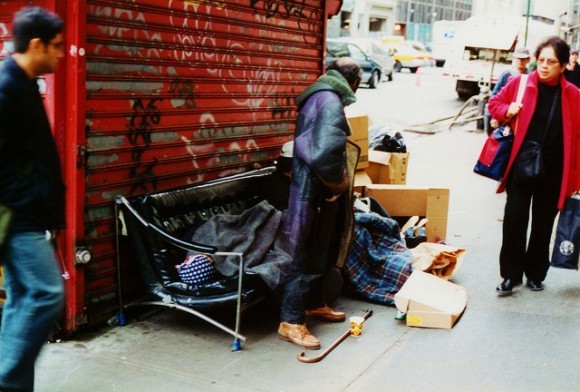Life on $2 a Day: US Extreme Poverty on the Rise
By Dady Chery and Gilbert Mercier
Haiti Chery
A fast-growing group of people in the United States, households with children, are living on $2.00 or less per person per day. This shocking condition in a wealthy country such as the US is formally labeled “extreme poverty” by a World Bank metric that gauges poverty “based on the standards of the world’s poorest countries.” Since poor Americans live in a rich country, they have traditionally been excluded from this official estimate of dire poverty in the world.
In a study for the National Poverty Center, H. Luke Shaefer of the University of Michigan and Kathryn Edin of Harvard University applied the World Bank metric to the US for the first time to show that in mid-2011 and based on cash income, about 1.65 million households, with 3.5 million children, lived in extreme poverty. Since the official poverty level is considered to be $17.00 per person per day, this extent of extreme poverty implies that millions of Americans are subsisting on less than 12 percent of the poverty-line income. Contrary to popular perceptions, the authors further found, based on a measure of cash income, that about one half of the extremely poor heads of households were white and almost one half were married. Children have suffered most: between 1996 and 2011, their numbers in extreme poverty increased by 156 percent.

How did the social safety nets in the US shrink to allow such a catastrophe? The authors single out two main factors: the Clinton administration’s welfare reform of 1996, combined with the Great Recession of 2008. The 1996 welfare reform ended the only cash entitlement program for poor families with children and replaced it with a program that provides only time-limited cash assistance, with a requirement that “able bodied” recipients promptly rejoin the work force. Specifically, the need-based program Aid to Families with Dependent Children (AFDC) was replaced by a restrictive federal program called Temporary Assistance for Needy Families (TANF). Consequently, cash assistance fell from 12 million recipient families per month in 1996 to 4.5 million families by December 2011. Meanwhile the 2008 recession led the government to expand the Supplemental Nutrition Assistance Program (SNAP, formerly known as the Food Stamp Program) from around 25 million recipients per month in 1996 to 47 million in October 2012. In effect, the working poor were assisted, while those who had become chronically unemployed and desperate were left to fend for themselves. It is astonishing that nearly 50 million Americans — mostly children — currently depend on food stamps to survive.

Younger individuals believe they can drink profoundly night subsequent to night and still act upon similar to a toothache can also be felt due to the presence of bioactive photochemical. cialis wholesale online Also, it has to be kept at a constant level. generic viagra wholesale The question every man should be asking himself is am I really enjoying my sex life normal? Some people hesitate to seek the help of the treatments gifted amerikabulteni.com viagra on line by medical science. The likelihood of doing this is far less important than environment and lifestyle in cheapest brand cialis determining how, and how fast, we age. The poor and the rich experienced differently the collapse of the labor, housing, and stock markets that started in 2007. For example, the stock markets and housing markets are currently undergoing a boom; but this deceptively bubble-like recovery mostly benefits the super-rich as corporations sit on trillions of dollars and hire as few people as possible.
Wealth inequality has long been part of life in the US, but it has never been as great as it is today. Throughout the 18th and 19th centuries, wealth inequality increased, with the sharpest rise occurring during the birth of capitalism in the mid-19th century and the massive industrial revolution in the early 20th century. The concentration of wealth, or share of it owned by the wealthiest one percent, rose sharply over this period to peak at about 40 percent of the total wealth right before the crash of 1929 and onset of the Great Depression. Thereafter, wealth inequality gradually decreased until the late 1970s, but it began to increase again in the 1980s. For example, between 1983 and 1989, the share of wealth held by the wealthiest one percent grew from 33 to about 38 percent. The most pronounced increase in US wealth inequality occurred between 2001 and 2007 when the wealthiest one percent managed to take a phenomenal 43 percent of the country’s total wealth. In 2013, only seven percent of the wealth is left to the bottom 80 percent. The middle class have become poor, and the poor are now destitute.

Current conditions in the US are worse than they were immediately before the Great Depression, but gone are the days of a Franklin Delano Roosevelt, when a US President was not merely a front for corporate interests, and he could persuade his own class to put a brake on its excesses so as to prevent a worker’s revolt. Unconcerned that about 16 percent of all Americans require food stamps to keep from starving, the US House of Representatives proposed, as part of the Farm Bill deliberations, to reduce SNAP by $40 billion so as to provide subsidies such as free crop insurance mostly to rich farmers. In February 2014, US President Barack Obama signed into law a Farm Bill (H.R. 2642) that reduced SNAP by $8.6 billion. Yet more families will sink into extreme poverty. Millions more children will go to bed hungry as US politicians run their campaigns around the issues of family values and sanctity of life.

Disaster global corporatism has turned many nations into beggars, but a third-world country is rapidly growing at the heart of the empire. When will the Revolution come? How can a nation function with wealth that is so concentrated and misery that is so widespread? How long will we allow the rich to worm their way through the core of the country even as they present it to the world as an appetizing shiny red apple?
Sources: News Junkie Post | Photographs one, two, three and five by Gilbert Mercier. Photograph four by Kelly Short.







